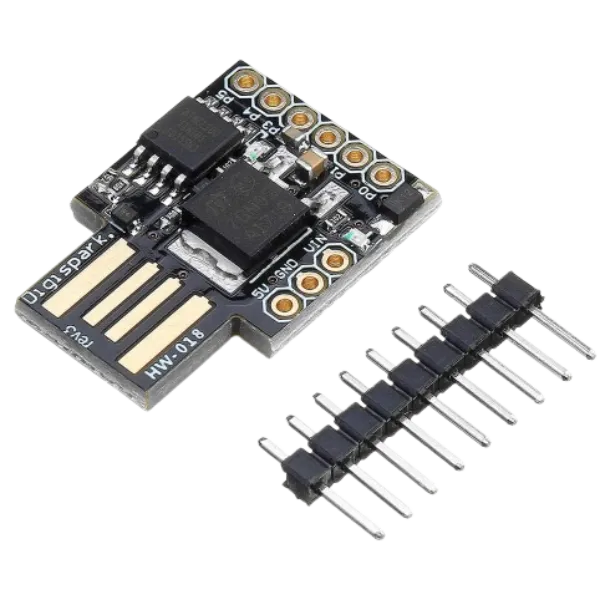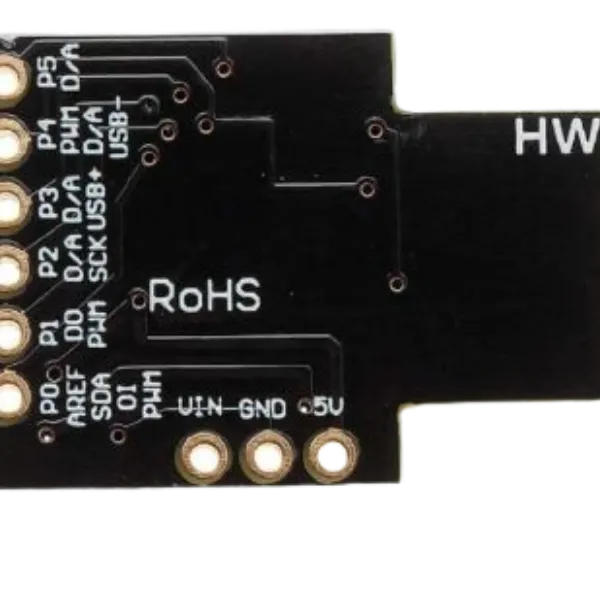Rs. 255.00Rs. 229.00
- Support for the Arduino IDE 1.0 + (OSX/Windows/Linux).
- Power via USB or External Source or 7-16 v to 5 v (automatic selection).
- The Onboard, 150 ma 5 v Regulator.
- Built-in USB and serial were debugging).
- 6 I/O Pins (2 inform the for USB only if your program actively communicates over USB, otherwise you can use all 6 even if you are programming via USB).
- 8 k Flash Memory (about 6 k after bootloader).
- The I2C and SPI (vis USI).
- The Power LED and the Test/Status LEDs.
The ATTINY85 USB Development Board is a compact and versatile microcontroller board designed for DIY electronics, embedded systems, and small-scale automation projects. It features USB programming, low power consumption, and is ideal for hobbyists and developers.
The ATTINY85 USB Development Board is a small yet powerful microcontroller board designed for a wide range of electronics and embedded systems applications. Built around the ATTINY85 microcontroller, this board offers great flexibility for projects that require low power and minimal space. Its USB interface allows for easy programming, making it an excellent choice for both beginners and experienced developers looking for a simple yet efficient solution for their projects.
Key Features:
- Microcontroller: ATTINY85, an 8-bit AVR RISC-based microcontroller
- Flash Memory: 8KB of flash memory, suitable for small-scale applications
- I/O Pins: 6 GPIO pins, supporting digital I/O, PWM, and analog input
- USB Programming: Easy USB connectivity for uploading programs without the need for an external programmer
- Low Power Consumption: Designed for energy-efficient applications, perfect for battery-powered projects
- Compact Size: Small form factor, making it ideal for wearable tech, compact IoT devices, and DIY electronics
- Compatibility: Compatible with Arduino IDE, making development and prototyping accessible to users familiar with Arduino
Applications:
- DIY Electronics: Perfect for makers and hobbyists to create simple yet effective projects.
- Embedded Systems: Can be integrated into small-scale embedded systems for custom automation solutions.
- IoT Devices: Suitable for low-power IoT applications, such as sensor nodes and smart devices.
- Wearable Technology: The compact size and low power make it ideal for wearable projects.
Ideal For:
- Makers and hobbyists looking to create DIY projects.
- Developers working on low-power, small-scale automation systems.
- Students and educators seeking an affordable, easy-to-use microcontroller for learning and experimentation.
- Clock Speed: The ATTINY85 operates at up to 16 MHz (using an external oscillator), making it capable of handling most small-scale projects efficiently.
- Operating Voltage: The board operates at 5V when connected via USB, but the ATTINY85 itself can run on a voltage range from 2.7V to 5.5V, making it suitable for battery-powered applications.
- USB Bootloader: Comes pre-loaded with a USB bootloader, enabling easy programming through the USB port without the need for additional hardware.
- Low-Power Modes: The ATTINY85 supports multiple low-power modes, such as idle, power-down, and ADC noise reduction, making it perfect for energy-sensitive projects.
- Dimensions: The board is incredibly compact, typically around 25mm x 20mm, allowing for easy integration into tight spaces.
- Support for Libraries: Compatible with various Arduino libraries, such as the SoftwareSerial library, making it easier to develop communication-based projects.
- Programming Interface: Programs can be uploaded using the Arduino IDE, making it beginner-friendly. The USB interface also eliminates the need for an external ISP programmer.
Package Includes:
- 1x ATTINY85 USB Development Board
- User manual or reference guide for setup (optional, depending on the provider)
Note:
- Ensure the correct drivers are installed for USB communication, which may be required for certain operating systems.
- The board may require some configuration in the Arduino IDE to ensure proper communication and uploading of code.










